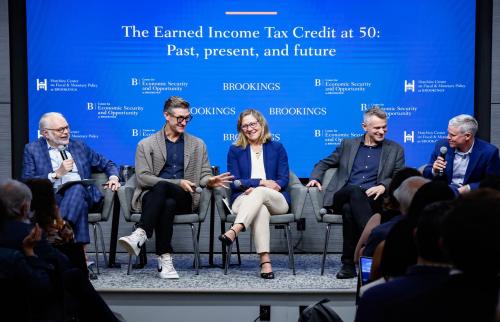Since 2000, the share of children in the U.S. living with at least one grandparent has increased by more than 36%, from 9.3% to 12.7%. By 2019, one in eight children lived with a grandparent. As families balance caregiving practicalities and household costs, the share of multigeneration and skip-generation families has grown significantly while the share of two-parent, parent-only households has declined.
Here we explore trends in children’s living arrangements from 2000 to 2019 and the implications for social safety net policy. We classify households into four categories:
- Parent-only: Parent-only households are households in which children live with one parent, two parents, or a parent and a parent’s partner.
- Multigeneration: Multigeneration households consist of a child, at least one parent, and at least one grandparent.
- Skip-generation: Skip-generation households are households in which a child lives with at least one grandparent, but no parent.
- Complex: The term “complex families” is used to describe households that don’t neatly fit the definition of parent-only, multigeneration, or skip-generation households, or where the relationship is unclear in the data. For example, a household consisting of only a child and her aunt would be classified as a “complex family.”
Children have become more likely to live in multigeneration and skip-generation households
Most children still live in parent-only households, but the share of children who live with grandparents has been increasing. Figure 1 displays two pie charts; the left shows children’s living arrangements in 2000 and the right shows the same in 2019. The total of the two orange sections of the pie—children in multigeneration and skip-generation households – equals the share of children who live with a grandparent—12.7% in 2019.
Between 2000 and 2019, the share of children living in either skip-generation or multigeneration households increased substantially. Single-parent living arrangements also increased during this time. The increase in children living with their grandparents is accompanied by a decline in children living in two-parent, parent-only households. In 2000, 69.8% of children lived in a nuclear two-parent household. By 2019, this share decreased to 65.1%.
Multigeneration households are more common than skip-generation and are increasing over time, with a particularly pronounced rise around the Great Recession. As can be seen in Figure 2, between 2007 and 2009, the share of children living with parents and grandparents rose from 7.8% to 8.9%. Families may choose to live in multigenerational households to protect against economic shocks or double up to facilitate care of children or older adults. Overall, multigenerational arrangements increased by over a third between 2000 and 2019, from 7.6% to 10.5%.
Though still rare, it also has become more common for children to live in skip-generation households over the past two decades. The share of children living in skip-generation households reached 2.2% in 2019, up from 1.7% in 2000. Often, children come into these living situations as the result of negative shocks such as parental inability to care for a child, death of a parent, and other crises. Children living in skip-generation arrangements are more likely to be living in poverty and facing multiple hardships.
There are different living arrangements across race/ethnicity groups
Figure 3 depicts the share of children living with at least one grandparent broken down by four mutually exclusive racial and ethnic groups: white, Black, Asian, and Hispanic. (A small number of children are not in these categories and multi-racial children are shown as part of the “total” line but not separately). Black and Asian children are consistently more likely to live with a grandparent than other children: More than 1 in 6 Black children live with their grandparents, and the share is similar for Asian children. Non-Hispanic white children are less likely to live with a grandparent than other major groups. However, this group also experienced the largest change over the 2000-2019 time period – from 5.8% to 9.2%.
Figures 4 and 5 show that there are important racial differences in the common types of grandparent living arrangements. Asian children most frequently (18% in 2019) live in multigeneration households, and more than 13% of Hispanic and Black children live in multigeneration households. The fraction of non-Hispanic white children living in multigeneration households is much smaller, about 7% in 2019, though it has increased substantially.
Figure 5 demonstrates that the fraction of children living in skip-generation households also differs by race/ethnicity. Black children are twice as likely to live in skip-generation households as those from other groups; as of 2019, 4.5% of Black children lived with only their grandparents. Since 2000, white children have become much more likely to live in skip-generation arrangements, whereas this jump is not evident for children from other major groups. Recent work suggests that the opioid drug crisis has impacted children’s living arrangements and led to more children living in households without their parents.
What does this mean for policy?
Though living with grandparents may help buffer families against economic shocks and provide welcome social support, multi and skip-generation households often face economic hardship. Seniors who live in households with children have higher rates of food insecurity and SNAP participation. Grandparent caregivers have double the poverty rate of the general population of older adults, and children who live in poverty are more likely to live in grandparent households than more economically advantaged children.
This raises the question of how families—particularly skip-generation families—navigate safety net systems that were not designed with grandparent households in mind. Although most safety net programs do not require grandparents to prove legal custody or guardianship, the multiple complex bureaucracies can be daunting, especially if grandparents are entering caregiving informally or unexpectedly. In a GAO analysis, more than a fifth of relative caregivers said they had found obtaining public assistance difficult, second only to childcare as a challenge.
Some skip-generation arrangements arise because parents are unable to care for their own children. Child protection systems increasingly prioritize kin care as an alternative to non-relative foster care, and a “kin first” approach appears to be better for children. If grandparents become licensed foster care providers, there is more financial support available through the foster care system than through safety net programs like Temporary Assistance to Needy Families (TANF), the cash assistance program mainly utilized by single-parent families. However, the vast majority of kin care arrangements—roughly 95%—are outside the foster care system.
Most states have kinship navigator programs which aim to inform and connect nonparental caregivers with case management and support services, sometimes focused on those in the child protection system and other times operating more broadly. The success of these programs suggests that they are a promising first step to ensuring skip-generation families have access to needed supports.
-
Acknowledgements and disclosures
The Brookings Institution is financed through the support of a diverse array of foundations, corporations, governments, individuals, as well as an endowment. A list of donors can be found in our annual reports published online here. The findings, interpretations, and conclusions in this report are solely those of its author(s) and are not influenced by any donation.
The Brookings Institution is committed to quality, independence, and impact.
We are supported by a diverse array of funders. In line with our values and policies, each Brookings publication represents the sole views of its author(s).






